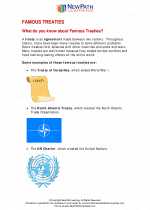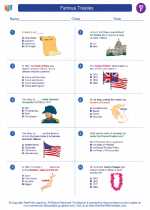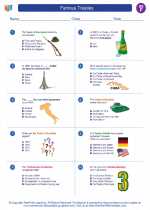◂Social Studies Worksheets and Study Guides Sixth Grade. Famous Treaties
Study Guide Famous Treaties
Famous Treaties  Worksheet/Answer key
Worksheet/Answer key Famous Treaties
Famous Treaties  Worksheet/Answer key
Worksheet/Answer key Famous Treaties
Famous Treaties  Worksheet/Answer key
Worksheet/Answer key Famous Treaties
Famous Treaties 

 Worksheet/Answer key
Worksheet/Answer key
 Worksheet/Answer key
Worksheet/Answer key
 Worksheet/Answer key
Worksheet/Answer key

The resources above cover the following skills:
National Curriculum Standards for Social Studies (NCSS)
TIME, CONTINUITY, AND CHANGE
SOCIAL STUDIES PROGRAMS SHOULD INCLUDE EXPERIENCES THAT PROVIDE FOR THE STUDY OF THE PAST AND ITS LEGACY.
KNOWLEDGE - Learners will understand:
The study of the past provides a representation of the history of communities, nations, and the world.
That learning about the past requires the interpretation of sources, and that using varied sources provides the potential for a more balanced interpretive record of the past.
That historical interpretations of the same event may differ on the basis of such factors as conflicting evidence from varied sources, national or cultural perspectives, and the point of view of the researcher.
Key historical periods and patterns of change within and across cultures (e.g., the rise and fall of ancient civilizations, the development of technology, the rise of modern nation-states, and the establishment and breakdown of colonial systems).
The contributions of key persons, groups, and events from the past and their influence on the present.
The influences of social, geographic, economic, and cultural factors an the history of local areas, states, nations, and the world.
GLOBAL CONNECTIONS
SOCIAL STUDIES PROGRAMS SHOULD INCLUDE EXPERIENCES THAT PROVIDE FOR THE STUDY OF GLOBAL CONNECTIONS AND INTERDEPENDENCE.
KNOWLEDGE - Learners will understand:
Global connections have existed in the past and increased rapidly in current times.
Global factors such as cultural, economic, and political connections are changing the places in which people live (e.g., through trade, migration, increased travel, and communication).
Global connections may make cultures more alike or increase their sense of distinctiveness.
PROCESSES - Learners will be able to:
Ask and find answers to questions about the ways in which people and societies are connected globally today and were connected in the past.
National Standards for Civics and Government (NSCG)
What is the relationship of the United States to other nations and to world affairs? How is the world organized politically?
Interaction among nation-states. Students should be able to explain how nation-states interact with each other. To achieve this standard, students should be able to
Describe the most important means nation-states use to interact with one another
Diplomacy
Treaties and agreements
United States' relations with other nation-states. Students should be able to explain how United States foreign policy is made and the means by which it is carried out. To achieve this standard, students should be able to
Describe various means used to attain the ends of United States foreign policy, e.g., diplomacy; economic, military, and humanitarian aid; treaties; trade agreements; incentives; sanctions; military intervention; covert action
International organizations. Students should be able to explain the role of major international organizations in the world today. To achieve this standard, students should be able to
Describe the purposes and functions of major governmental international organizations, e.g., UN, NATO, OAS, World Court
National Content Standards in Economics (NCSE)
Trade
Students will understand that voluntary exchange occurs only when all participating parties expect to gain. This is true for trade among individuals or organizations within a nation, and among individuals or organizations in different nations. Students will be able to use this knowledge to negotiate exchanges and identify the gains to themselves and others. Compare the benefits and costs of policies that alter trade barriers between nations, such as tariffs and quotas.
At the completion of Grade 8, students will know the Grade 4 benchmarks for this standard, and also that:
Free trade increases worldwide material standards of living.
The gains from free trade are not distributed equally, and some individuals or groups may lose more than they gain when trade barriers are reduced.
At the completion of Grade 8, students will use this knowledge to:
Look at historical examples of periods when the United States has imposed trade barriers and explain why the U.S. government would impose trade barriers given the mutual benefits of free trade.
National Center for History in Schools (NCHS)
Historical Thinking Standards
Chronological Thinking
Identify the temporal structure of a historical narrative or story.
Reconstruct patterns of historical succession and duration; explain historical continuity and change.
Historical Comprehension
Reconstruct the literal meaning of a historical passage.
Identify the central question(s) the historical narrative addresses.
Historical Analysis and Interpretation
Draw comparisons across eras and regions in order to define enduring issues.
Challenge arguments of historical inevitability.
Hold interpretations of history as tentative.
Historical Research Capabilities
Formulate historical questions.
Historical Issues-Analysis and Decision-Making
Identify issues and problems in the past.
Identify relevant historical antecedents.
United States History Content Standards
Era 3: Revolution and the New Nation (1754-1820s)
The causes of the American Revolution, the ideas and interests involved in forging the revolutionary movement, and the reasons for the American victory.
The student understands the factors affecting the course of the war and contributing to the American victory.
Era 7: The Emergence of Modern America (1890-1930)
How the United States changed from the end of World War I to the eve of the Great Depression.
The student understands politics and international affairs in the 1920s.
Era 10: Contemporary United States (1968 to the present)
Economic, social, and cultural developments in contemporary United States.
The student understands economic patterns since 1968.
World History Content Standards
Era 8: A Half-Century of Crisis and Achievement, 1900-1945
The causes and global consequences of World War I.
The student understands the global scope, outcome, and human costs of the war.
The search for peace and stability in the 1920s and 1930s.
The student understands postwar efforts to achieve lasting peace and social and economic recovery.
The causes and global consequences of World War II.
The student understands the global scope, outcome, and human costs of the war.
Major global trends from 1900 to the end of World War II.
The student understands major global trends from 1900 to the end of World War II.
Era 9: The 20th Century Since 1945: Promises and Paradoxes
The search for community, stability, and peace in an interdependent world.
The student understands major sources of tension and conflict in the contemporary world and efforts that have been made to address them.
Major global trends since World War II.
The student understands major global trends since World War II.